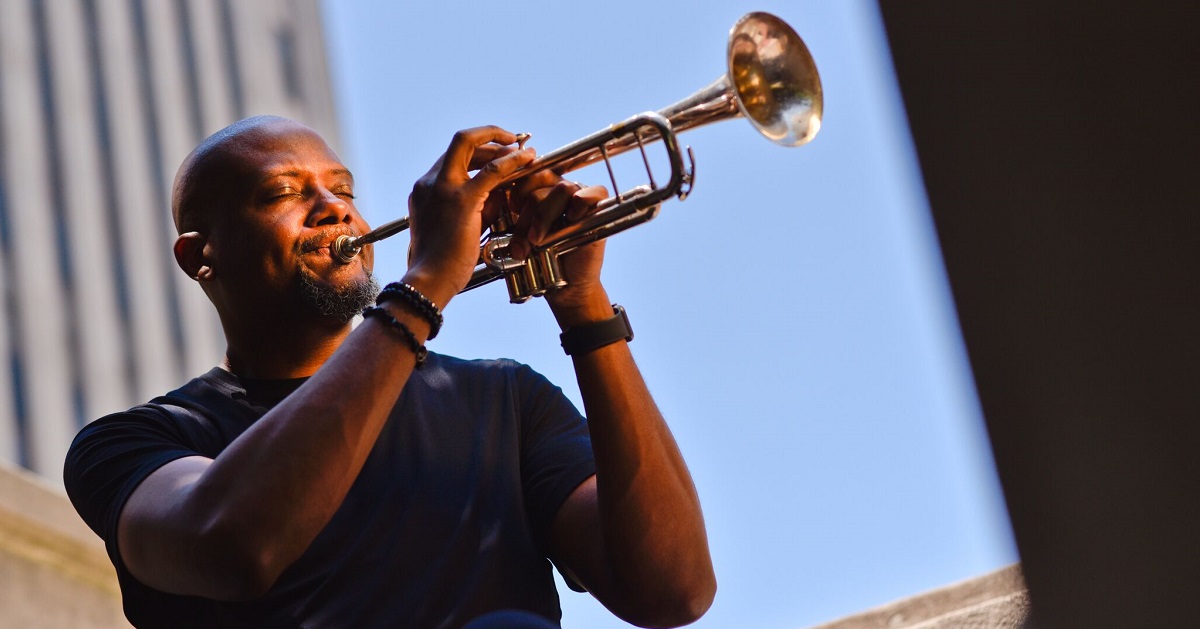
Jazz and humanity, a discussion about 2021 with trumpeter Sean Jones
During his visit to Charlotte for the performance of “We Insist!”, we interviewed international jazz trumpeter Sean Jones about his view of the future of jazz. Not only is Sean a musician and educator with a span of experience from San Francisco to New York and beyond, but he is uniquely positioned as the current President of the Board of the Jazz Education Network. This month, he’s also been featured in Downbeat Magazine. Here is a piece of our conversation with him, as he expresses his broad view of the new opportunities and challenges of this art form:
How do you see the pandemic affecting music now and in future?
Musicians have been recording remotely for years – that is not necessarily new. What is new is how you engage with the audience. For me, livestreaming is still a concert. If someone pays $50 to go downtown to see you perform on a Friday night, they will be more invested. A livestream that can be archived to watch whenever you want. Why would they sit down and check you out? You must grab people to engage with them.
People have to reinvent themselves. Folks accustomed to only performing live music with an acoustic bass, piano, drums, and sax, must deal with technology.
The biggest fear I have is that, through the pandemic, people are getting accustomed to seeing things for free. I don’t think any time someone is doing work; it should be free.
Ultimately, I think the music will be the same. People always want the same things: good food, to feel wanted, to feel they can express themselves without serious backlash, to address their physical needs. We want to be human. If you can conjure that humanity during a performance, you have won.
In your role with the Jazz Education Network, what are some of the current priorities in the support of jazz music?
Reflecting the issues of what’s going on in this country, for example, gender inequalities. To deal with the issue of women in leadership positions, target young women early on. When it’s time to introduce kids to instruments in school, encourage the girls toward rhythm instruments prevalent in jazz like drums and saxophone, rather than only flute and clarinet.
There needs to be an organic conversation around what it means to be an improviser of this music. Focus on learning to improvise, rather than creating big band charts. The notes on the page are a means to the end, it is not the destination. It is a map, but you must drive there.
Back in October, we were thrilled to have you join us for the We Insist! Freedom Now Suite tribute production. How do you feel this music connects to what we are dealing with today?
We are literally living experiences that were lived when the record was done, still fighting for justices, for equality, still dealing with PTSS – “post traumatic slave [syndrome]”. African Americans are people that have ancestry brought over in the [trans-Atlantic] slave trade. There are generations of trauma that we’re still dealing with today. I think sometimes we forget that.
In the recording, of We Insist!, Max Roach used time signatures and harmonics that make you feel off kilter. Blues is normally 12 bars, but he offers one in 6 bars. You have a harmonic expansion, adding a note that is unexpected. It creates this brows-up, what’s going on here, almost loopy feeling.
When you perform “We Insist!” now, [as a musician] you want to reimagine things a little, because music has life. When you play something that is so storied, you want to stay true to its purpose but also to bring freshness to it. We expanded the ensemble a little with the trombone [and piano], and adjusted the chord structures of the solo sections.